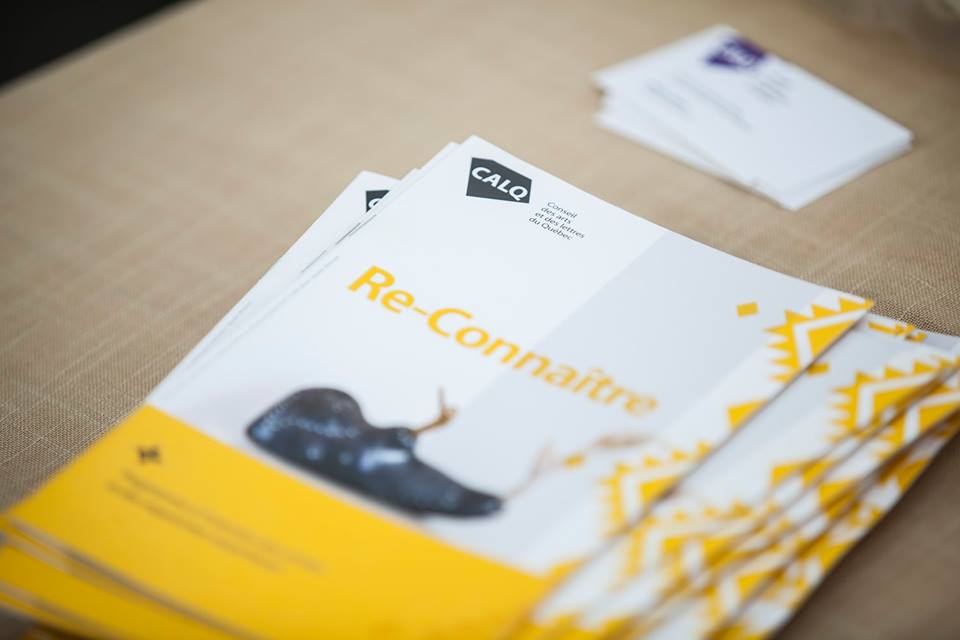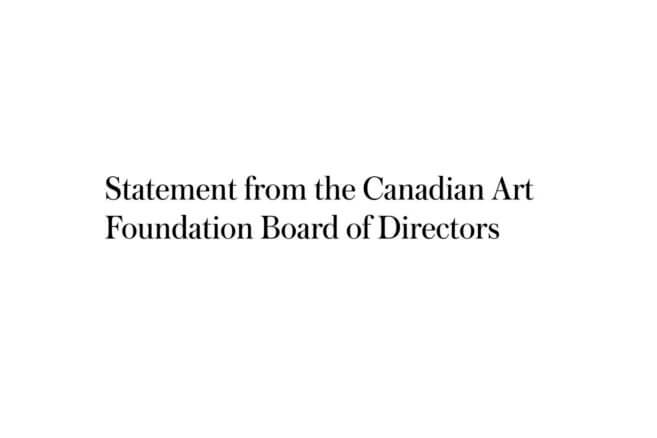Serious questions have emerged this month about equity for Métis artists in Quebec.
In early April, Melanie Lefebvre, a Montreal-based Métis artist, became aware that the Conseil des arts et lettres du Québec was not accepting applications from Métis artists in its new Recognition Program for Indigenous People.
“Under this program the Métis Nation is not recognized, even though Métis are recognized as Indigenous peoples under Section 35 of the Canadian Constitution,” Lefebvre tells Canadian Art via email.
“Métis people are federally recognized as Indigenous peoples,” Lefebvre adds. “CALQ should not promote a funding stream for Indigenous people residing in the province of Quebec if they are excluding a recognized Indigenous nation.”
Métis artist Moe Clark, who lives in Montreal, is also concerned about the fact that Métis artists are not able to apply to the Recognition Program.
Clark says they recently had to take a day off work to support a younger Métis artist who was deeply disturbed by the fact that the CALQ did not recognize them as Indigenous—even though the Constitution states they are.
“The CALQ is creating these programs and supposedly has done all this work to consult,” says Clark, “and yet there is still a huge level of harm that is being done because of this exclusion.”
CALQ Cites Provincial “Legal Framework” As Cause
When Lefebvre took to Twitter to express some of these concerns on April 3, the CALQ tweeted back that “Quebec’s current legal framework does not allow the CALQ to accept Métis artists in the Recognition Program. However, Métis artists can apply in the Grant to Artists program and ask to be assessed by the Recognition Jury.”
What is this legal framework the CALQ refers to?
“It’s not something that I have power over,” says Anne-Marie Jean, CEO of the CALQ, in an interview with Canadian Art. “We have to follow the guidelines that are given to us—but in the meantime we are making sure that these [Métis] artists can still have access to programs and can receive money to create.”
In that interview and a related email, CALQ representatives referred to multiple ongoing court cases in the province of Quebec related to claims of Métis identity.
Jean also noted that there was a council of some 20 Indigenous artists involved in development of the CALQ’s Recognition Program.
“We raised this fact” with the council during the program development consultation process in 2017 and 2018, says Jean. “It took us 18 months to develop the program…. And the last four months of the process we had a final decision according to the Secretariat des affaires autochtones and we developed the alternative for Métis [applicants].”
(The alternative Jean refers to is the fact that Métis artists can request that the Recognition Program jury evaluate their grant application if they so wish.)
Ultimately, Jean says, that there is no set cap on Recognition Program funding; it’s flexible, with no limit on the pot of money to use up. And she also says she will adjust the program as soon as she gets a different legal guideline from the provincial government.
“In the end, it’s just the entrance door that is different,” contends Jean, “In the end, they receive the money; our responsibility is to make sure that they have access.”
Legal Cases Ongoing Regarding Quebec Métis—But Implications Vary
Two Métis academics whom Canadian Art contacted for comment regarding legalities of Métis in Quebec recommended speaking to French-Canadian scholar Darryl Leroux of Saint Mary’s University in Halifax.
Leroux is an expert on claims to Métis identity in Quebec whose research focuses on the “dynamics of racism and colonialism among [his] fellow French descendants.” He says that while multiple court cases are indeed ongoing, they affect only the idea of a specifically “Quebecois Métis” identity, and not the rights of already recognized Métis in Canada.
“I would be a bit surprised if that’s what they were doing…. If the [CALQ funding] program is saying no to Métis people,” says Leroux in a phone interview. “Because clearly there are Métis people who live in Quebec, who are descended from the Métis nation out west…. If they are excluding those people from funding I would be really surprised.”
In Leroux’s research, a summary of which was recently published in Maisonneuve magazine and is forthcoming in his book Distorted Descent: White Claims to Indigenous Identity, Leroux shows that several groups’ courthouse claims to a “Quebecois Métis” nation have actually been made by white-rights activists following hunting and land disputes.
Partly as a result, so far, says Leroux, “The province of Quebec and the Federal Government don’t recognize a distinct Quebec Métis people—and they don’t recognize any Eastern Métis people.”
Leroux, like many other researchers, still affirms that under the law and the Canadian Constitution, Métis people are Indigenous people—and that’s why the CALQ policy remains a surprise to him.
And Montreal-based artist Moe Clark says the Province of Quebec, CALQ included, needs to do better at navigating issues around Métis identity.
“It’s one thing not to recognize Métis in Quebec,” says Clark. “It’s another thing for an arts council to deny an entire nation of Métis people who are recognized under the Supreme Court.”
Clark suggests there are other ways the CALQ in particular could have made its process more equitable.
“They didn’t really consult with Métis,” says Clark, referencing the fact that only one of the 20 artists on the CALQ’s consulting council for the Recognition Program is identified as Métis. “We weren’t at the table when these decisions were being made…. Maybe they could have asked if there was some way we could help determine who is in the community. There is a lot of self-identification that happens in our nations, outside of genealogy and outside of band status.”
Canada Council Métis Artist Guidelines Differ from CALQ’s
In order to see how other arts councils deal with the current Quebec court case situations and their legal implications, Canadian Art contacted the Canada Council.
What we found is that the Canada Council has a less restrictive approach to Métis applicants—even though it is well aware of contestations and court cases around claims to a specific “Quebecois Métis” identity.
At the Canada Council, Métis artists are eligible for Indigenous-related program funds.
This is because, “as articulated in the Canadian constitution, Métis are one of three distinct Indigenous groups in Canada,” says Steven Loft, director of the Creating, Knowing and Sharing program, via email.
When asked if there was any distinction made at the Canada Council between “Quebecois Métis” and other Métis people, Loft said no—though another spokesperson indicated the Council is following the current Quebec conversation and court cases closely.
The Canada Council also uses a self-identification guideline for First Nations, Inuit and Métis artists—rather than an external identification guideline, as the CALQ does.
When asked how self-identification works at the Canada Council, Loft explained, “At the beginning of the application form on the portal, applicants are asked whether they are a First Nations, Inuit, or Métis individual, group or organization, be selecting yes or no from a drop-down menu.”
By contrast, at the CALQ, applicants are requested to supply “a document certifying…Indigenous status” when submitting their first application to the Recognition Program, says the council website. Such documents include, CALQ’s website says, an “Indian status card” or “Inuit beneficiary card.”
But, says the CALQ website as well, “if you do not have those documents, the CALQ will determine your eligibility based on the responses provided” in the grant application.
Still Looking for Answers and Action
Last week, Canadian Art requested further explanation from Quebec government representatives about legal frameworks and funding implications surrounding Métis people in Quebec—both in and beyond the arts—but no response was received by press time.
Melanie Lefebvre is still concerned about issues left hanging by the CALQ response she received on Twitter April 3.
“I’ve been living on this territory as an uninvited guest of the Kanien’kehá:ka people for 35 years,” Lefebvre says via email. “My ancestry is Red River Metis, Plains Cree, Nakota, Saulteaux, French and Irish. My Native father and grandmother were born on this land…. I have lawfully paid Quebec taxes since I was 15 years old. I’ve given my life to this province.”
Though many are concerned about the white supremacy and white-rights movements claiming to Métis identity in Quebec, Lefebvre also points out that Quebec agencies refusing service to Métis, or refusing to recognize Métis as Indigenous people as is required under constitutional law, also reflects a white supremacist ethos.
“The sheer audacity that the Quebec government and by extension CALQ has to refuse to support my people is at a bare minimum, violent and racist,” concludes Lefebvre, “and frankly, so typical of the white supremacy in the province.”
Artist Moe Clark says pushing for a better way of supporting Métis artists in Quebec is vital—because it’s not just about funding, it’s about other forms of support, too.
“I want CALQ to be held accountable for how this system they have developed is racist and exclusionary,” says Clark, “But I also want to find space to change this and make it work.”
Clark also notes the bias evident in the CALQ’s policies, and the province’s, is troubling—but not uncommon both in and beyond Québec’s borders.
“Our arts systems and funding bodies have a long way to go in terms of addressing how we are going to work in an Indigenous way to ensure cultural safety and inclusion,” says Clark, “not just trying to write about it or promote it from a surface level, but to actually have it in the functioning and administering of a program.”

 Brochures for the CALQ's Recognition Program for Indigenous People at the program's launch in Montreal in August 2018. Photo: Facebook / CALQ.
Brochures for the CALQ's Recognition Program for Indigenous People at the program's launch in Montreal in August 2018. Photo: Facebook / CALQ.




